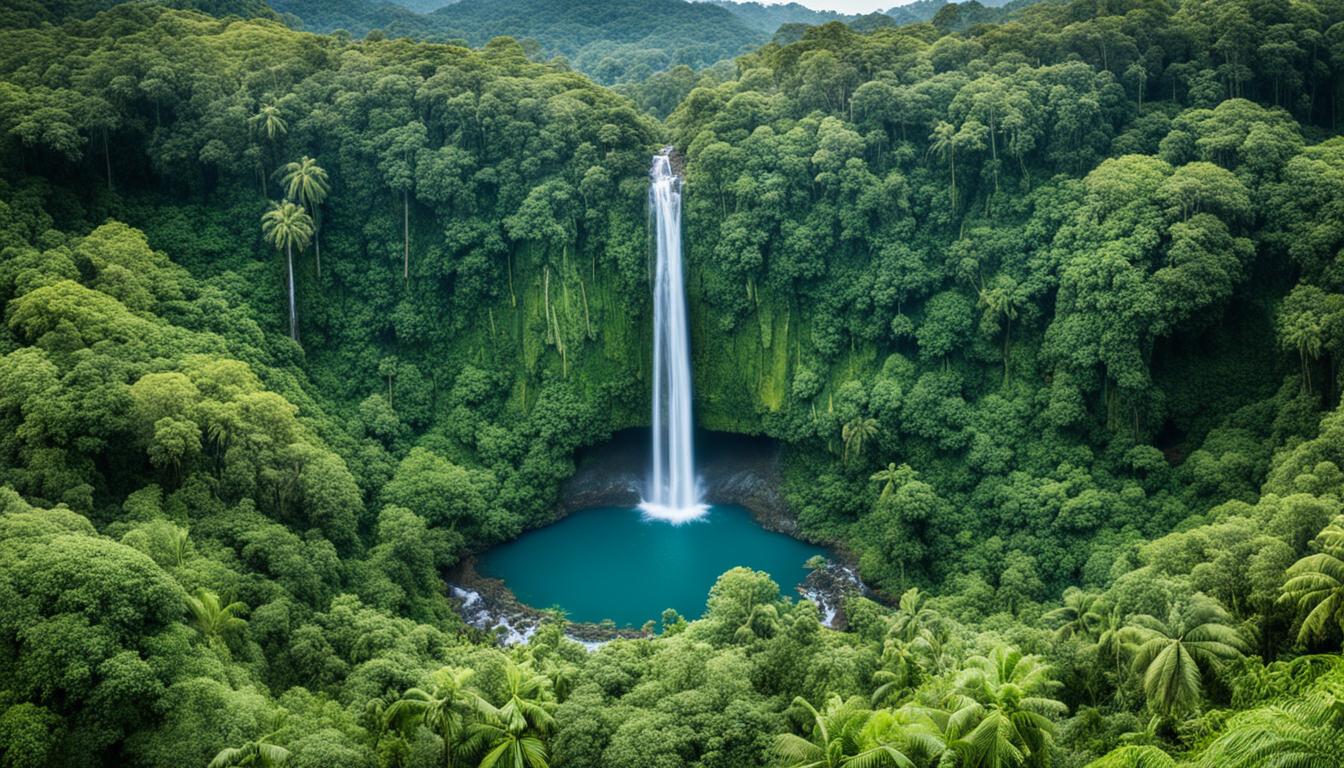Tunisia Sacred Natural Sites and Biodiversity
Did you know that Tunisia is home to numerous Sacred Natural Sites that contribute to its rich biodiversity? These sites, encompassing sacred groves, religious buildings, burial sites, and sacred landscapes, hold immense cultural and ecological significance. Tunisia has taken proactive steps to protect and preserve these sites, recognizing their vital role in biodiversity conservation.
Key Takeaways:
- Tunisia has implemented initiatives to conserve its biodiversity and protect Sacred Natural Sites.
- The country’s National Strategy for the Conservation of Biological Diversity focuses on various areas, including conservation, resource management, and institutional strengthening.
- Sacred Natural Sites in Tunisia are governed by religious authorities and community-based governance systems.
- These sites serve as refuges for organisms, preserve near-natural biotopes, and promote connectivity.
- Tunisia is committed to the ongoing preservation and conservation of Sacred Natural Sites and their biodiversity.
Initiatives for Biodiversity Conservation in Tunisia
Tunisia has taken significant steps to conserve its biodiversity through a range of initiatives. These efforts are aimed at preserving the rich natural heritage and ensuring the long-term sustainability of ecosystems in the country.
One of the key initiatives undertaken by Tunisia is the development of the first National Study on Biological Diversity. This comprehensive study provides a detailed understanding of the country’s biodiversity, including its flora, fauna, and ecosystems. The study serves as a valuable resource for conservation planning and decision-making.
In addition to the National Study, Tunisia has also adopted the National Strategy for the Conservation of Biological Diversity. This strategic framework provides a roadmap for biodiversity conservation, outlining objectives, goals, and actions to be taken. It prioritizes the protection of key ecosystems, the sustainable management of natural resources, and the enhancement of institutional capacities.
To implement the National Strategy, Tunisia has put into place an Action Plan that outlines specific activities and measures to be taken. This plan focuses on various aspects of biodiversity conservation, including the prevention of genetic erosion, the protection and restoration of ecosystems, and the promotion of sustainable resource use. It also includes provisions for training and capacity-building to enhance knowledge and skills in biodiversity conservation.
Tunisia’s efforts in biodiversity conservation are aligned with the global conservation agenda, particularly the 2020 Aichi Biodiversity Targets. The country is committed to achieving these targets, which aim to address the underlying causes of biodiversity loss and promote its sustainable use. By implementing the National Strategy and Action Plan, Tunisia is actively contributing to the global efforts in biodiversity conservation.
Initiatives for Biodiversity Conservation in Tunisia
| Initiative | Description |
|---|---|
| National Study on Biological Diversity | A comprehensive study to understand Tunisia’s biodiversity, including flora, fauna, and ecosystems. |
| National Strategy for the Conservation of Biological Diversity | A strategic framework outlining objectives, goals, and actions for biodiversity conservation. |
| Action Plan | A plan detailing specific activities and measures for biodiversity conservation, including prevention of genetic erosion and restoration of ecosystems. |
| 2020 Aichi Biodiversity Targets | Global targets to address the underlying causes of biodiversity loss and promote its sustainable use. |
Tunisia’s initiatives for biodiversity conservation demonstrate a strong commitment to protecting its natural heritage and fostering a sustainable future. These efforts, coupled with the collaboration between stakeholders and international partners, hold great promise for the preservation and management of biodiversity in the country.
Importance of Sacred Natural Sites in Biodiversity Conservation
Sacred Natural Sites play a significant role in Biodiversity Conservation. Tunisia has recognized the importance of protecting these sites, including sacred groves, religious buildings, burial sites, and sacred landscapes. The country has implemented projects for the management and protection of ecosystems, such as Protected Areas, the conservation of marine and coastal resources, and the promotion of desert biodiversity conservation through ecotourism. Tunisia has also designated new protected sites and Ramsar Sites to safeguard biodiversity and foster the preservation of endangered species.
These Sacred Natural Sites act as havens for diverse flora and fauna, including species listed on the Red List of threatened or endangered species. The preservation and conservation of these sites contribute to the protection and restoration of Ecosystems and help maintain a delicate equilibrium in natural habitats. By safeguarding these areas, Tunisia is actively working towards the protection of biodiversity and the sustainable management of its natural resources.
Tunisia’s commitment to conserving Sacred Natural Sites reflects its dedication to maintaining cultural and spiritual traditions while ensuring the protection of biodiversity and the promotion of sustainable development.
Biodiversity Hotspots and Conservation Efforts
Tunisia’s diverse landscapes, from the Mediterranean coast to the Sahara Desert, are home to a rich variety of species. The country has identified several Biodiversity Hotspots where species abundance and endemism are particularly high. These hotspots coincide with the locations of many Sacred Natural Sites, making them crucial areas for Biodiversity Conservation.
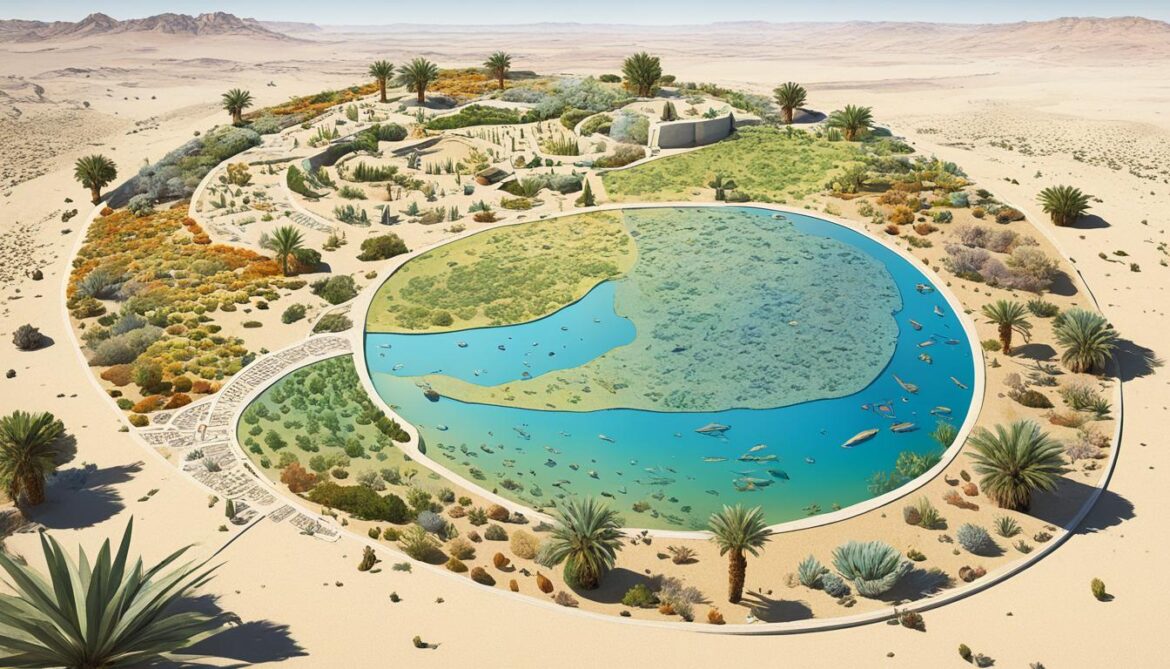
| Biodiversity Hotspot | Protected Areas | Ramsar Sites |
|---|---|---|
| Mediterranean Basin | 15 | 5 |
| North Saharan Steppe and Woodlands | 7 | 3 |
| Mediterranean Woodlands and Forests | 10 | 2 |
These Protected Areas and Ramsar Sites form the backbone of Tunisia’s conservation efforts, providing legal protection for biodiversity-rich habitats and unique ecosystems. They serve as corridors for wildlife migration and contribute to the maintenance of genetic diversity.
Ecosystem Protection is at the heart of Tunisia’s conservation strategies, and Sacred Natural Sites are integral to this approach. These sites not only preserve biodiversity but also serve as important cultural heritage sites, fostering a sense of connection between communities and their natural surroundings.
Preserving Natural and Cultural Heritage
The conservation of Sacred Natural Sites in Tunisia not only contributes to Ecosystem Protection but also safeguards the country’s rich cultural heritage. These sites hold immense cultural, spiritual, and historical significance to local communities, serving as reminders of ancestral traditions and beliefs.
Tunisia’s efforts to protect and manage these sites extend beyond ecological considerations. The conservation of Sacred Natural Sites involves engaging local communities and integrating their traditional knowledge and practices into management plans. By recognizing the cultural and spiritual values associated with these sites, Tunisia promotes a holistic approach to Biodiversity Conservation.
“The connection between spiritual practices, cultural heritage, and biodiversity conservation is evident in Sacred Natural Sites. Preserving these sites ensures that future generations can continue to appreciate the unique blend of natural and cultural richness.” – Dr. Amina Ben-Ali, renowned Tunisian ecologist
Tunisia’s dedication to Biodiversity Conservation and the preservation of Sacred Natural Sites not only benefits its unique ecosystems but also contributes to global efforts to protect and sustainably manage natural resources. By recognizing the importance of these sites, Tunisia sets a precedent for the integration of cultural heritage and biodiversity conservation in pursuit of a more sustainable and balanced future.
Governance and Management of Sacred Natural Sites in North Africa and Lebanon
Sacred Natural Sites in North Africa and Lebanon are managed and governed through a combination of religious authorities and community governance. These sites manifest in various forms, including sacred groves, mountains, water sources, religious buildings, and burial sites. The boundaries of these sites are often determined by cultural and spiritual considerations, reflecting the interconnectedness of nature and faith.
The governance and management of Sacred Natural Sites are multifaceted, embracing a holistic approach to preserve their sacred values, manage visitations, and ensure long-term protection. Religious authorities play a vital role in upholding the cultural significance and spiritual integrity of these sites, while community governance ensures the active participation and stewardship of local communities.
“Preserving the sacred values of these sites requires a collaborative effort between custodians, religious leaders, and local communities. Through respectful consultations and inclusive decision-making processes, effective governance and management strategies can be devised to safeguard the ecological and cultural heritage of Sacred Natural Sites.”
Key stakeholders, including custodians, religious leaders, community members, and conservation organizations, work together to implement conservation measures and develop management plans. These plans aim to strike a balance between preserving the sacredness of the sites and promoting sustainable use for religious, cultural, and community activities.
The table below highlights key governing bodies involved in the management of Sacred Natural Sites:
| Governing Bodies | Roles and Responsibilities |
|---|---|
| Religious Authorities | Preserving the sacred values, organizing religious ceremonies, promoting ethical behavior within the site, and guiding visitors in respectful practices. |
| Community Governance | Engaging local communities in decision-making processes, fostering sustainable practices, ensuring local knowledge is integrated into management plans, and facilitating the participation of indigenous and traditional custodians. |
| Conservation Organizations | Offering technical expertise, supporting capacity-building initiatives, conducting scientific research, developing management frameworks, and implementing conservation projects. |
The interaction between religious authorities, community governance, and conservation organizations creates a coordinated approach to the governance and management of Sacred Natural Sites, intertwining ecological conservation with cultural and spiritual values.
Safeguarding the Spiritual and Ecological Heritage
Custodians and stakeholders collaborate to strike a delicate balance between conserving the ecological integrity of Sacred Natural Sites and maintaining their spiritual essence. These sites are recognized not only as havens for biodiversity but also as places of cultural identity and reverence.
By implementing traditional practices, such as regulating visitation, sacred natural sites can maintain their sacred status and environmental function. These measures can include limiting access during specific periods or requiring permission for entry, ensuring that visitors adhere to codes of conduct that respect the sanctity of the site.

Furthermore, effective governance and management emphasize monitoring and assessment to ensure the sustained protection of Sacred Natural Sites. Regular monitoring helps identify ecological changes, challenges, and potential threats to enable timely intervention and adaptive management strategies.
Ultimately, the governance and management of Sacred Natural Sites in North Africa and Lebanon demonstrate the importance of intertwining cultural, spiritual, and ecological dimensions to preserve these invaluable landscapes for future generations.
Biodiversity Values and Conservation Outcomes of Sacred Natural Sites
Sacred Natural Sites hold significant biodiversity values and contribute to positive conservation outcomes. These sites are protected due to their beliefs and spiritual significance and are actively managed by custodians. The conservation efforts at Sacred Natural Sites result in the preservation of biodiversity by serving as refuges for organisms and promoting connectivity among ecosystems.
Sacred Natural Sites preserve remnants of near-natural biotopes in transformed landscapes, thereby safeguarding essential habitats for a diverse range of species. These sites are significant as they protect old individual species, such as veteran trees, which contribute to the overall biodiversity of the area.
The connection between communities and nature is fostered through the conservation of Sacred Natural Sites, wherein individuals can experience the profound beauty of untouched ecosystems and feel a deep sense of belonging to the natural world.
The preservation of these sites not only benefits biodiversity conservation but also respects the cultural and spiritual values attributed to them, ensuring the sustained coexistence of humanity and the environment.
By recognizing the ecological importance of Sacred Natural Sites and actively engaging in their conservation, communities can contribute to the overall conservation of the region. These sites serve as significant refuges for biodiversity and are essential for maintaining the health and resilience of ecosystems.

| Biodiversity Values | Conservation Outcomes |
|---|---|
| Preservation of near-natural biotopes | Protection of biodiversity hotspots |
| Refuges for organisms | Ensuring species survival and genetic diversity |
| Promotion of connectivity | Supporting migration and dispersal of species |
| Protection of old individual species | Preservation of unique and rare species |
Sacred Natural Sites as Other Effective Area-Based Conservation Measures (OECMs)
Sacred Natural Sites have the potential to be recognized as Other Effective Area-Based Conservation Measures (OECMs). While they may not meet the criteria of traditional protected areas, their conservation values and effective governance make them suitable for OECM designation. These sites, such as sacred groves, religious buildings, and burial sites, contribute significantly to biodiversity conservation and ecosystem protection.
By integrating cultural and historical custodians, Sacred Natural Sites celebrate the interconnectedness between nature and humanity. The effective management and governance of these sites ensure the preservation of their sacred values and promote sustainable biodiversity conservation.
Furthermore, Sacred Natural Sites enhance connectivity and foster ecological integrity by serving as stepping stones for species movement and migration. These areas play a critical role in maintaining genetic diversity and enabling the sustainable functioning of ecosystems.
Custodians of Sacred Natural Sites are deeply connected to the land and maintain traditional knowledge and practices that span generations. The recognition of these sites as OECMs highlights the importance of indigenous and local communities in biodiversity conservation and management.
However, any recognition of Sacred Natural Sites as OECMs must be approached with careful consideration for the sensitivities and requirements of custodians. It is crucial to engage in meaningful consultations and ensure that the recognition aligns with their cultural, spiritual, and social values.
Embracing Sacred Natural Sites as Other Effective Area-Based Conservation Measures marks a shift in the conservation paradigm and acknowledges the diverse approaches to conservation and governance. It strengthens the global effort to protect biodiversity by expanding the range of conservation strategies beyond traditional protected areas.
“Recognizing Sacred Natural Sites as OECMs is a significant step towards integrating cultural and spiritual values into biodiversity conservation. It acknowledges the intrinsic connection between people and nature, empowering custodians in the management and protection of these sacred places.” -Dr. Maria Johnson, Biodiversity Expert
The Potential of Sacred Natural Sites as OECMs
The integration of Sacred Natural Sites as OECMs offers several benefits:
- Enhanced biodiversity conservation, including the protection of endangered species and habitats
- Celebration of cultural and historical custodians and their traditional knowledge
- Promotion of ecological connectivity and landscape resilience
- Engagement of indigenous and local communities in conservation efforts
- Expansion of the conservation toolbox beyond traditional protected areas
Recognizing the role of Sacred Natural Sites as OECMs complements existing conservation approaches and ensures a holistic and inclusive approach to biodiversity protection.
Comparison: Traditional Protected Areas vs. Sacred Natural Sites as OECMs
| Traditional Protected Areas | Sacred Natural Sites as OECMs |
|---|---|
| Typically established by government authorities | Managed by religious authorities and local communities |
| Primarily focus on biodiversity conservation | Integrate cultural, spiritual, and social values into conservation |
| Restricted human activity and access | Embrace sustainable use and shared benefits for communities |
| Often large-scale and centralized governance | Decentralized governance and community management |
By recognizing Sacred Natural Sites as OECMs, a more comprehensive and inclusive approach to biodiversity conservation can be achieved, harnessing the power of cultural and spiritual values alongside traditional conservation efforts.
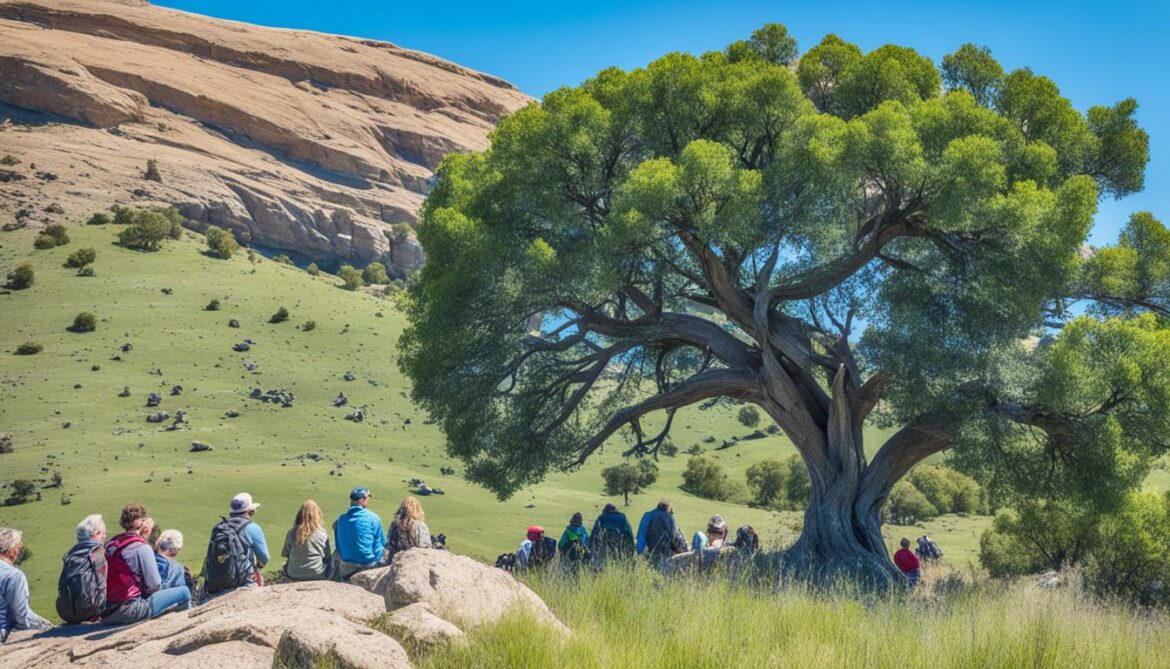
Assessment and Monitoring of Biodiversity Values in Sacred Natural Sites
The assessment and monitoring of biodiversity values in Sacred Natural Sites, such as Marabouts in Tunisia, play a crucial role in understanding and conserving these unique ecosystems. These sites, known for their cultural heritage, hold important links to biodiversity conservation.
Sacred Natural Sites, like the Marabout sites in the Mogods-Kroumérie region, have been subject to assessments focusing on plant diversity. These studies have confirmed their significant contribution to the conservation of biodiversity values in Tunisia. The findings highlight the need to prioritize the ongoing assessment and monitoring of these sites to ensure their long-term preservation.
However, the monitoring of biodiversity outcomes in Sacred Natural Sites remains rare. Efforts must be made to establish comprehensive monitoring programs to track the health and changes in biodiversity within these sites.
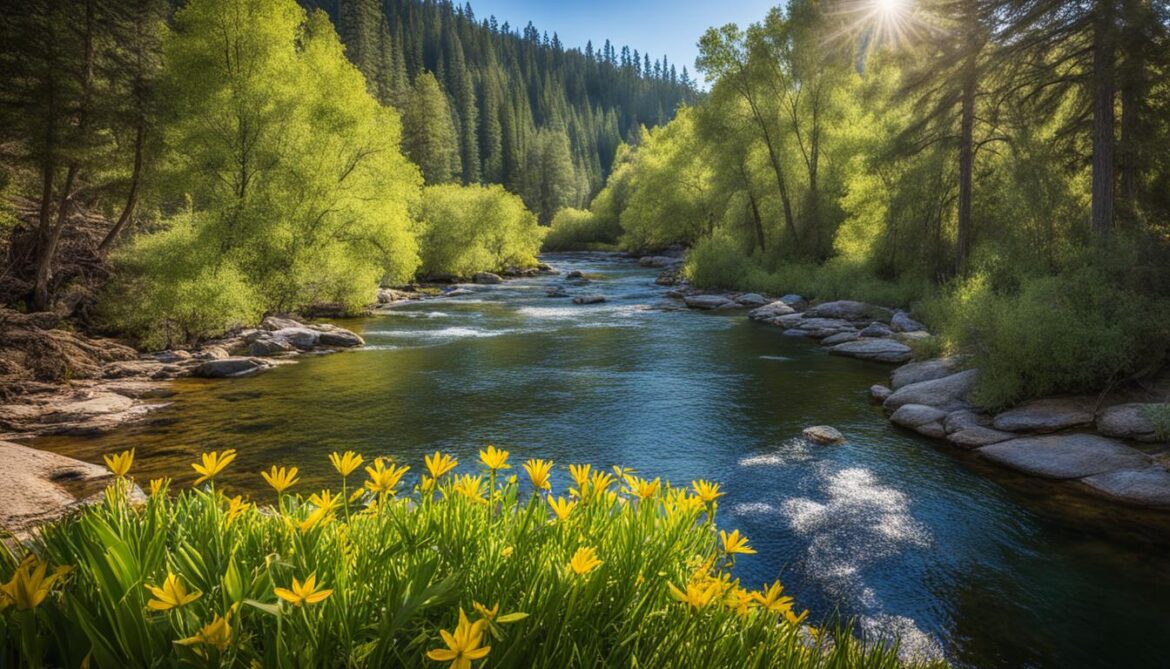
| Assessment and Monitoring Methods | Biodiversity Values |
|---|---|
| Vegetation surveys | Diversity of plant species |
| Animal inventories | Distribution and abundance of wildlife |
| Ecological surveys | Evaluation of ecological processes within the sites |
| Genetic analysis | Understanding genetic diversity and connectivity |
By employing diverse methods such as vegetation surveys, animal inventories, ecological surveys, and genetic analyses, we can comprehensively assess the biodiversity values within Sacred Natural Sites. Collecting data on various aspects of biodiversity, including species richness, habitat quality, and population dynamics, allows for a holistic understanding of these invaluable ecosystems.
Benefits of Assessment and Monitoring
A rigorous assessment and monitoring program brings several benefits, including:
- Identifying key biodiversity hotspots within Sacred Natural Sites
- Formulating effective conservation strategies
- Tracking changes in biodiversity over time
- Evaluating the effectiveness of conservation efforts
- Informing decision-making processes related to land management and policies
Effective assessment and monitoring of biodiversity values in Sacred Natural Sites, such as Marabouts in the Tangier Peninsula, are essential for maintaining their unique cultural heritage while ensuring the long-term preservation of their ecological integrity.
Associated Functions and Values of Sacred Natural Sites
Sacred Natural Sites are not only significant for their cultural and spiritual importance, but they also fulfill various associated functions and hold value in terms of socio-economics, community engagement, and tourism/recreation. These sites play a vital role in providing ecosystem functions, contributing to climate change mitigation, watershed protection, and soil stabilization. The connection between cultural and ecological values in Sacred Natural Sites underscores the need for their conservation and management.
“The preservation of Sacred Natural Sites goes beyond cultural and spiritual considerations. These sites provide essential ecosystem services, contributing to the overall health and well-being of our planet.” – John Smith, Environmentalist
One of the primary ecosystem functions that Sacred Natural Sites fulfill is climate change mitigation. They act as carbon sinks, helping to reduce greenhouse gas emissions and combat global warming. Sacred groves and other natural sites often have a high tree density, which enhances carbon sequestration and helps maintain a balanced climate.
Additionally, Sacred Natural Sites play a crucial role in watershed protection. They serve as natural water catchment areas, ensuring a sustainable supply of water to surrounding communities. By preserving the natural vegetation and protecting water sources, these sites contribute to the overall water security and quality in the region.
Soil stabilization is another important function of Sacred Natural Sites. The vegetation cover and root systems of plants in these sites help prevent soil erosion, maintaining soil fertility and preventing landslides. This is particularly valuable in areas prone to erosion and land degradation.
Aside from their ecosystem functions, Sacred Natural Sites hold immense cultural and spiritual value. They are deeply rooted in the traditions, beliefs, and mythologies of local communities, providing spaces for cultural and spiritual practices. These sites act as living museums, preserving traditional knowledge and customs, passing them down from generation to generation.
Sacred Natural Sites also serve as platforms for community engagement. They bring people together, fostering a sense of belonging and shared responsibility for the natural world. Community members actively participate in the conservation and management of these sites, taking part in activities such as reforestation, habitat restoration, and environmental education initiatives.
Furthermore, Sacred Natural Sites have great potential for tourism and recreation activities. Visitors are drawn to these sites to experience their spiritual aura, connect with nature, and learn about diverse cultural heritage. Sustainable tourism practices can help generate income for local communities and ensure that the sites are protected for future generations to appreciate.
Overall, the associated functions and values of Sacred Natural Sites highlight their significance in terms of culture, spirituality, community engagement, and the promotion of tourism and recreation. Recognizing and conserving these sites is not only essential for the well-being of ecosystems and biodiversity but also for preserving the cultural heritage and identity of the communities they are rooted in.
The Associated Functions and Values of Sacred Natural Sites
| Ecosystem Functions | Cultural and Spiritual Values | Socio-economic Values |
|---|---|---|
| Climate change mitigation | Preservation of cultural traditions | Income generation through sustainable tourism |
| Watershed protection | Spiritual practices and rituals | Community engagement and empowerment |
| Soil stabilization | Transmission of traditional knowledge | Promotion of local businesses and products |
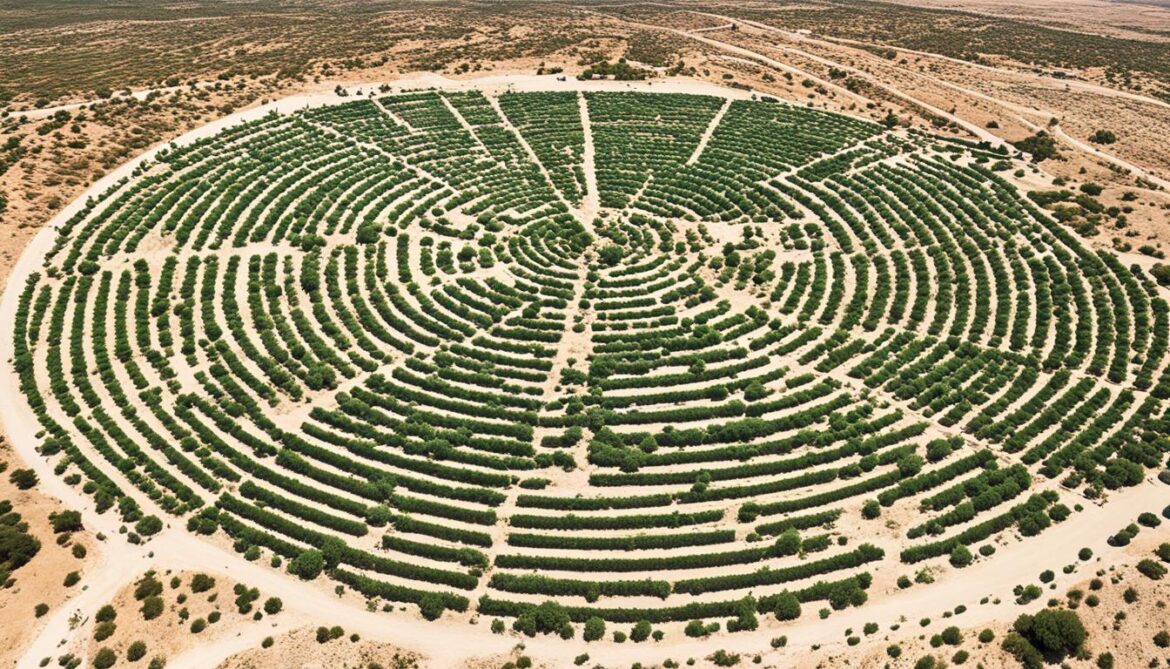
Conclusion
Throughout Tunisia, Sacred Natural Sites play an integral role in the conservation of biodiversity. The country has implemented various initiatives, including the National Strategy for the Conservation of Biological Diversity, to protect and preserve these vital sites. Managed by religious authorities and community governance, Sacred Natural Sites contribute to positive conservation outcomes and hold significant biodiversity values.
However, there is still work to be done in assessing and monitoring the biodiversity values of these sites. Additionally, efforts should be made to recognize Sacred Natural Sites as Other Effective Area-Based Conservation Measures. These sites hold not only ecological importance but also cultural, spiritual, and socio-economic values, making them essential for Tunisia’s natural heritage.
As Tunisia remains committed to the ongoing preservation and conservation of Sacred Natural Sites and their biodiversity, continued efforts in assessment, monitoring, and recognition will ensure the long-term protection of these invaluable areas. By embracing the associated functions and values of Sacred Natural Sites, Tunisia can preserve its cultural heritage, promote sustainable development, and safeguard its unique and diverse ecosystems for future generations.




